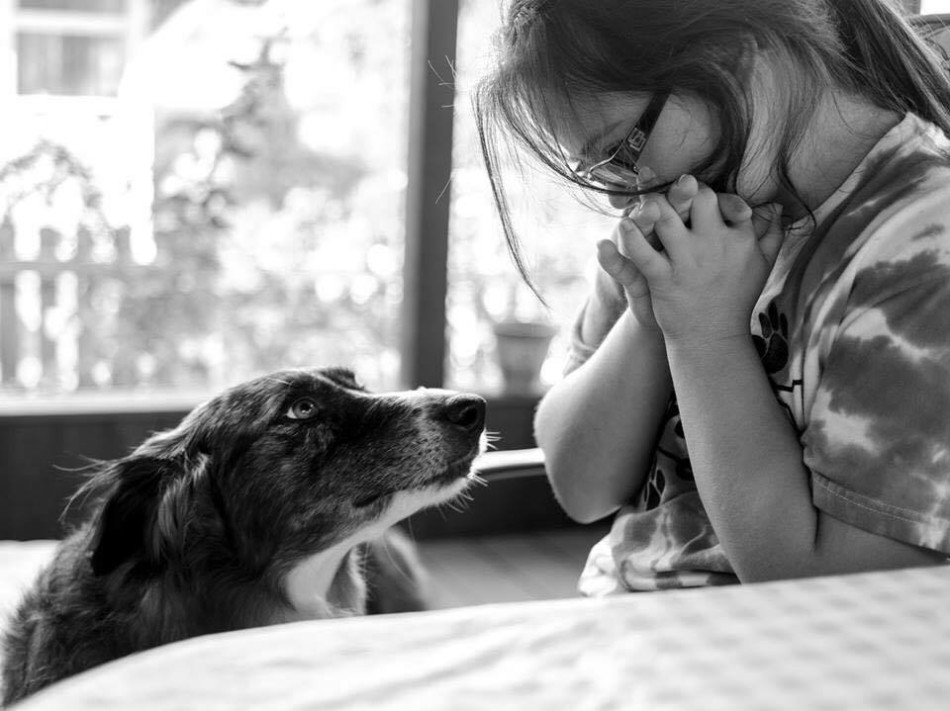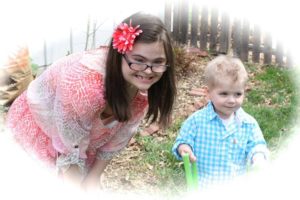Yesterday, I said I would run a few older blogs that I hope will be helpful. Home-school communication is one of the top issues for families. I hope this helps.
Communication 101 for Educators (Reprinted from April 2014)
If you do not tell us what happens at school, WE DO NOT KNOW!
That should be the blog with no further commentary. In conversing with families over the course of the past probably 12 years, I think that the number one issue is communication with professionals. Specifically, communication from the school including educators, administrators, related service personnel and office staff. I cannot speak to every child or every disability but I know for most of the students I know with Down syndrome, it is “Mission Impossible” to get an accurate accounting of what happens at school, therapy or whatever during the day from our children. Rachel is verbal and has good communication skills. Still, it is a like an interrogation to find out what has actually happened at school. This is usually followed by my winning meanest prosecutor of the year and both of us having a meltdown. She sometimes says “my brain is full” and my Down syndrome medical experts tell me that this true.
Overall, I would say that we have had pretty good communication through the years especially in Rachel’s younger years. We had a communication notebook in the early days that teachers used to communicate with us. Rarely did we have an issue with the teacher or therapists. However, we did have one therapist who needed more than a little prodding. We developed a sheet that the therapists used to note that they had actually seen Rachel and a checklist of what they had done. There was a space for more information if they needed it. I understand that all parents are not me, but we are involved parents. We want to know what you are doing at school and in therapy so we can follow-up and reinforce at home. My daughter has Down syndrome. Even if she has good communication skills, she has an intellectual disability. It’s part of the reason she needs an IEP and “special education services.” If you do not tell us what happens at school, WE DO NOT KNOW!
However, families continuously tell me that this back and forth communication in some form is an issue. Recently a mom of a kindergarten child shared that she had sent many unreturned emails to her case manager. Frustrated and angry, she went to the principal with unreturned emails in hand and said, “Look at all these emails. I’m frustrated. I’m angry and I no longer trust you.” The principal is a good sort and was quite unhappy that she no longer trusted them. The principal is trying to repair the situation. I have high hopes. Mom told the principal “If you do not tell us what happens at school, WE DO NOT KNOW!” Basically, the response was that the principal had not thought of that. Since this email is not about the absurdity of that, I will stay on my communication theme. Note, I do encourage parents to loop in the principal on communication before it gets to this point. Often that is all it takes to get more effective communication.
As students get older, there is apparently an assumption that this ability to tell us what we need to know changes. These very people who work with our children on a daily basis and tell some of you how incapable your children are, apparently assume that the Communication Fairy waves her wand and our children come home and with great accuracy tell us what their homework is or that the speech therapist restrained them inappropriately or that they were bullied at school. Not so much. And yes, this paragraph is a little sassy. Remember, I am TheSassySouthernGal but this is not meant to disrespect the many great communicators and educators we all work with!
One of the reasons that the beginning of the school year brings me a bit of angst, especially when we got to middle school, is because there seems to be a problem getting communication going. As Rachel gets older, there are even more players (teachers) to coordinate. Every year we try to put in place some things that will help at the beginning of the year, but every year it seems to be a bit of an issue. That said, what I want educators to know is that when this happens, when we fail to get a response acknowledging our message (email or in writing) or we do not hear from you at all, we began to obsess. We work ourselves into a frenzy of all that might be wrong. Maybe you are very busy but acknowledge receipt in some way. When you don’t and we do not hear back or hear from you at all, we have worked ourselves into anger so that when we do get communication we do not react in the most positive manner. Rachel’s iPad might come home with a note in her Notability agenda that says “no HW.” However, the 25 pound binder with enough paper to kill three trees in the homework section? It says homework. Which one is it, Rachel? Then ensues another prosecution. Or maybe we find among the killed trees HW geography map due Friday but the note on the iPad says due tomorrow. Which one is it?
Then there is the case of the announcements. If the announcement sheet is not posted online, you need to assume that if you do not tell me I WON’T KNOW. So if a spirit day has been moved or there is money due for something that was not noted on the announcements, someone needs to get that information to me. Sometimes Rachel hears that there is a pancake breakfast for the choir but only gets home with “we’re having a pancake breakfast.” I can check the online announcements and usually get my answer.
I always want to be part of the solution, so some thoughts here.
- Communication notebook is an essential for preschool and elementary students and depending on the student may be essential through high school. As parents we understand you can’t write lengthy reports every day, but remember if you don’t tell us we won’t know so if you can at least give a checklist of what was done it is most helpful. We found a checklist to make everyone more efficient. A longer note per week would be helpful too or alternate note days.
- Related services professionals need to somehow let parents know that the child was seen. A checklist is great for this, and we parents need a note on what’s happening from you every now and then as well. The IEP may require communication each time you see the child. If so, you are legally bound to find time to communicate. We had a therapist in the early years who went three weeks without seeing the preschool kids. That’s a blog in and of itself but needless to say once we figured that out, Rachel got herself a new therapist. And no Rachel didn’t tell me she was not being seen.
- I’m not clear why many school districts seem to be so highly opposed to paraprofessionals communicating with parents but this seems to be a common concern. We have had a few paraprofessionals who do communicate with us directly with the school’s knowledge. They are with our kids a lot so it makes sense. By not allowing them to communicate with parents, it may also create an atmosphere of mistrust with parents. It is a “what are you trying to hide mentality.”
- We have found the iPad to be very helpful with communication. We use Notability for Rachel’s agenda and notes go back and forth. We still have a section in her 25 pound notebook for homework, and I have requested that homework has a notation written in the corner saying when it is due and HW. I have another folder in this notebook I have named “Stuff I Don’t Know What to do With.” Have you figured out that these notebooks with all this paper in them is a source of frustration for me? This additional folder has also helped. You can also take pictures of chalkboards or assignments and video messages for home school communication. We’ve not done much of this but we wouldn’t like to do more of it.
- Every parent is different but my preferred method is by email. Rachel’s case manager and teacher email me on a regular basis. It usually makes for smooth communication back and forth.
- School website and/or newsletters.
- Sometimes the best thing is to just use the old-fashioned telephone. Often something is lost in the translation or misconstrued in email or texting so sometimes just call.
- Texting -Rachel’s teachers have texted us from time to time. However, some teachers may not want to give you their personal contact information, and I think we as parents should respect that. I appreciate the teachers who do entrust me with their number and try to be respectful of using this avenue.
I know some families get push-back from school districts and personnel for some of these approaches. I just want to say “figure it out” and get it in the IEP that this is how you are going to communicate. As parents you can point back to the IEP for accountability. Professionals who may be reading this, trust me if you communicate effectively, the year will run more smoothly.
Finally please communicate positive and negatives. Please don’t just communicate when something bad happens. If you don’t tell me the good things that happen, I WILL NOT KNOW!
Pictures of some of our communication methods. We do a lot of email but the preschool MOOSE Notebook was introduced by the preschool teacher and then carried through 5th grade. Inside were check sheets and sections for notes from teachers and therapists. Very effective and easy to use.
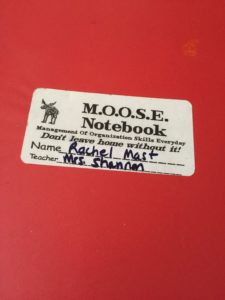
This is a screenshot of Rachel’s Notability app on her iPad. Helps her keep organized and provides a place for notes to come home. We sometimes struggle with the notes being specific enough or matching the papers in the notebook, but overall it works quite well. She can help write the notes, too. She was also very proud that she has taught several teachers/paras how to use this. 🙂
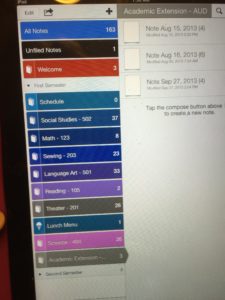
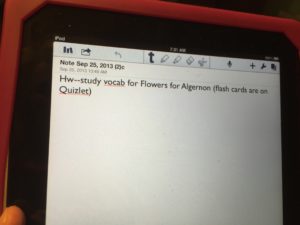
And for your viewing pleasure, this is a picture from April 2015 when this blog originally posted. It is Rachel and our neighbor’s little boy. He is heading to kindergarten tomorrow and we are so excited for him!
